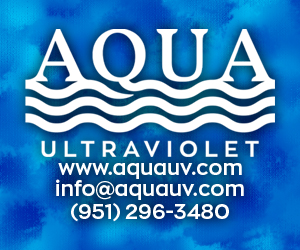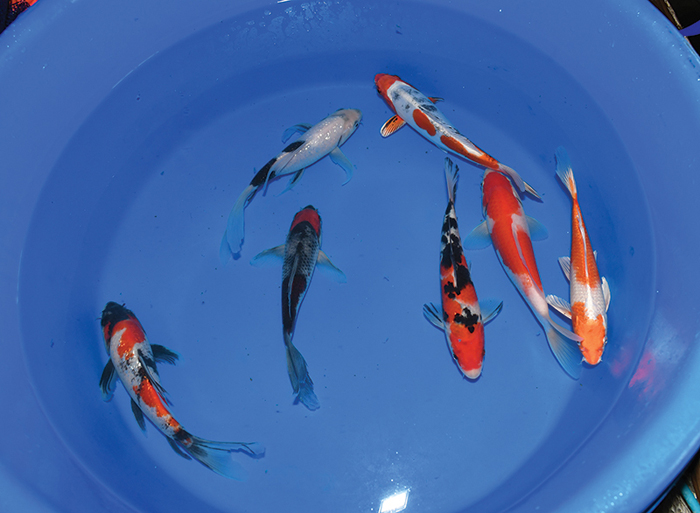
We all know that stress is a part of everyday life, and you probably have your own methods of coping with it.
Although you may not realize it, koi experience trauma related to stress as well. Because of their size, koi appear to be very hardy fish, and they are — as long as their environment is properly maintained. They can be quite sensitive to sudden changes in their environment, and this can cause undue stress.
In large part, keeping or retailing koi is all about managing the holding tank or pond ecosystem so that it remains as stable as possible. Koi are happiest in a consistent setting. Without intervention, fish may have difficulty overcoming serious tension and strain that can result from specific triggers. Changes in environment, water temperature, water quality or pond conditions can stress koi. Introducing new fish to a pond can also increase stress on the existing koi. Physical issues may arise due to the additional demands on water and filtration. Koi commonly exhibit signs of stress when dealing with illness and parasites, too.Every fish is different, and some are better than others at dealing with changes within their tank or pond. If a problem goes untreated, eventually all the koi will show symptoms of stress and may even perish. It is important to identify the causes of stress and improve water quality conditions as soon as any symptoms appear in your koi.
Symptoms of Koi Stress
Be on the lookout for any change in koi activity that could represent the presence of a stressor. Watch for behavioral differences, such as swimming sluggishly, refusing food or self-isolating. Stressed fish often have a desire to break away from the group or hide. Missing or ignoring these sometimes-subtle signs could put your fish stock in great danger.
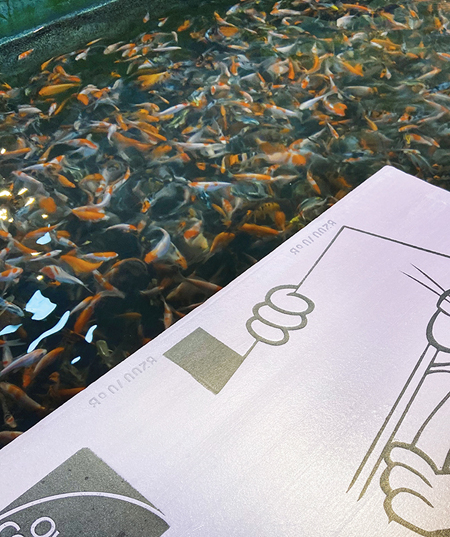
Koi may also exhibit physical changes when stressed, including rashes, which can manifest as a pinkish color all over the body, and especially on the fins, sores or spots. These could be a sign of a bacterial or parasitic infection as well. Torn fins, damaged scales and even cuts and blood spots could also suggest problems with mishandling or a predator in a pond setting. On a stressed koi, the normally vivid colors will slowly fade and lighten, becoming dull and subdued.
Be watchful for changes in the appearance and behavior of your fish stock in order to effectively detect stress. This means that you must know what “normal” looks like. Take a few minutes to visually examine your koi daily, paying close attention to the fins. Koi fins have a tendency to deteriorate when under stress. If you notice fins with tears, ragged or uneven edges, splits, reddening or red streaks, your koi may be experiencing stress.
Once you can identify the symptoms of koi stress, you need to understand the cause in order to fix it. Symptoms of stress may be identical for different stressors, so it’s not always easy to pinpoint the underlying problem. Keep in mind that there may be multiple stressors affecting your fish simultaneously.
Water quality is a major cause of fish stress. The stability of your tank or pond water is essential to maintaining koi health. Even a gradual change in the water quality can cause fish to show signs of stress. Swings in water quality can occur from fluctuations in levels of ammonia, nitrites, nitrates, pH, KH and dissolved oxygen. Monitoring these parameters is very important to avoid excessive fish stress. If you are moving koi, be sure that the water is cycled correctly prior to introducing fish to the pond or tank for a smooth transition.
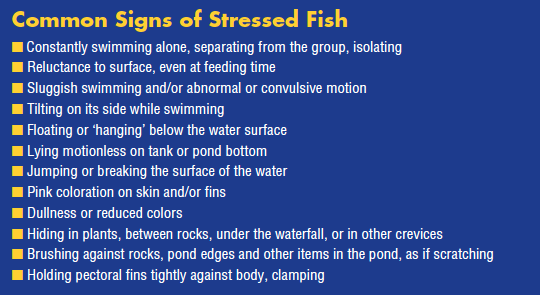
Parasites are a fact of life in the koi world. Any body of water that contains fish also contains parasites. Healthy koi can and do host parasites in small quantities. When fish are weakened and stressed, the parasites are encouraged to breed excessively and flourish. Koi can host both internal and external parasites. Some parasites such as flukes, anchor worms and fish lice can cause changes in both the appearance and behavior of koi. Parasites may be difficult to identify because most are microscopic. A microscope is necessary for most koi parasite identification. Adult anchor worms and fish lice are visible to the unaided eye, but as they are quite small, they can be easily overlooked. The signs of parasite infestations in koi are comparable to symptoms from other stressors. Koi may exhibit a number of behaviors, including rubbing on the pond edges, loss of appetite, lethargy, isolation, “panting” or bleeding gills, foggy eyes, physical changes to the skin, swelling, bumps and sores, reddening of skin or fins, tilting to the side, lying on the bottom of the tank or pond, and staying near high-oxygen concentration areas, like air stones or a water inlet.
Predators are another common source of stress on koi. Most backyard koi ponds are safe from predators, although some may be subject to attack from neighborhood cats, raccoons, mink and a variety of birds. If a pond is near a wooded area or stream, you may have a greater probability of natural predators visiting and causing chaos.
When stalked by predators, koi fish may show typical signs of stress, such as darting, hiding or refusing food. Signs of being attacked by a predator can include scratches, bodily injury, torn scales, damaged fins and reluctance to surface.
Handling can also be very stressful for fish. Whether you are moving fish for a pond cleanout or showing them to a customer in your store, the fish will experience stress. Always maintain a highly oxygenated vessel for the koi, and don’t forget to be extra careful not to damage the fins or slime coat.
Other potential stressors include pollution, which can result from incorrect water treatments or contaminants from insect or yard spray. A diet with an imbalance of proteins or amino acids can also cause problems.
Overcrowding of fish can lead to aggression and the accumulation of nitrogenous wastes, including ammonia and nitrite. Microorganisms like bacteria, fungus and algae can also upset a pond’s equilibrium and impact its inhabitants. Huge swings in temperature or periods of intense sunlight have their own adverse effects, as can loud and abrupt noises around the pond, which is amplified underwater.As there are many potential stressors that could affect your koi, it is a good idea to maintain a journal for your retail tanks, pond and fish. Both positive and negative occurrences should be recorded. This journal will be an invaluable reference tool when you’re trying to pinpoint a potential problem. When faced with a sick or stressed-out fish, you’ll be glad that you took the time to make each entry.
Reducing Koi Stress
If you are unsure of the cause of stress in your koi, your first step should be to test the water. Sudden changes in pH, oxygen or ammonia could be causing the stress. Commercial water test kits can be used to test for imbalances in ammonia, pH, nitrites, nitrates and oxygen, as well as KH and GH. A rapid increase or decrease in pH can kill koi. Ammonia tends to gradually build up over time, wreaking havoc. Be aware that ammonia’s toxicity is dependent on the pH levels and water temperatures, so as these levels rise, any lingering ammonia can have a deadlier effect. Monitoring water quality should become part of your maintenance routine.
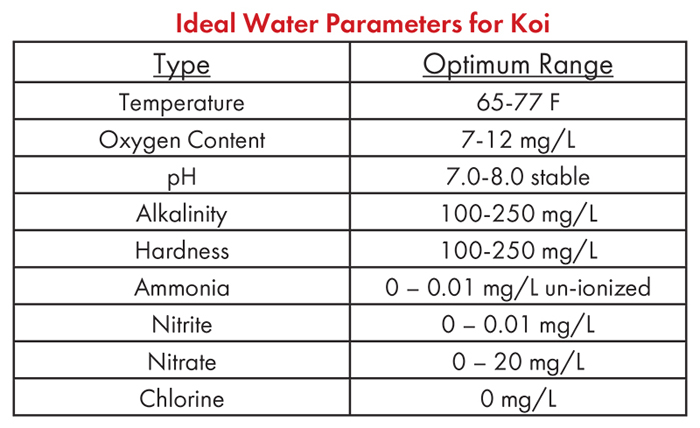
In addition to testing the water, you should also test and record the parameters of your source water. Many municipal water supplies contain high levels of ammonia, as well as toxic chlorine and chloramines. Well water can also contain high levels of ammonia. Performing water changes in an attempt to reduce ammonia is futile if the source water contains high ammonia levels, too! Stability is important for koi, so do not create drastic fluctuations when fixing water-quality issues. Make gradual adjustments to return the water parameters to the desired levels.
Koi that reside in clean and highly oxygenated water are less likely to be stressed. Be sure to periodically check your aeration equipment to ensure adequate oxygen is provided. Replacing air stones is an inexpensive way to reduce the threat of low dissolved oxygen conditions. The use of high-quality beneficial bacteria is vital for maintaining ideal water quality, which works along with mechanical filtration to remove solids.
Protecting Your Koi
Predators create an enormous amount of stress in the koi pond by stalking and chasing fish. Depending on your location, you may have a variety of predators seeking an easy snack from your pond. Various signs of an outside visitor include tracks, droppings, trampled plants, missing fish and stressed or injured fish. Also, koi may refuse to feed. Removing or deterring predators depends on the type of animal that is interfering with the pond. Chasing and catching koi in a retail setting can simulate predatory behavior. Always move nets slowly and carefully so as not to injure the koi’s slime coat when bowling koi for customer viewing.
Like humans, when koi can relax and feel safe, they will stress less often. Shelter can be made with rocks that are stacked to create crevices and caves, though be sure that they will not tip, possibly crushing or injuring fish. Waterlilies or floating plants that cover a large surface area may prove places for fish to seek shelter, too.
Bottom line, preventing the causes of stress is much easier than dealing with the results of it. Regularly clean your retail systems and your pond. Monitor water quality, treat for parasites if necessary, handle koi gently and protect your pond from predators to ensure that you maintain a healthy and stress-free environment for your happy koi.
